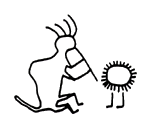| |
Our inspiration is initially that of Taos
and the "Taos Masters." The State of New Mexico’s designation as
"The Land of Enchantment" is well-deserved and we believe that the "enchantment"
begins in the three neighboring villages of San Geronimo de Taos (the
Indian pueblo), Don Fernando de Taos (the Spanish adobe village centered
on the old plaza) and Ranchos de Taos (the Spanish adobe village centered
around the Catholic Church).
In 1893 Joseph Henry Sharp visited the Taos
valley in order to finish a commission for "Harper’s Weekly" magazine.
His painting, "The Harvest Dance of the Pueblo Indians of New Mexico"
appeared in that magazine's issue of October 14th. The fall of 1895 found
Sharp studying art in Paris at the Academie Julien. Two younger American
students named Ernest Blumenschein and Bert Phillips were also studying
at the Academie and the three became friends. Sharp told Blumenschein
and Phillips about his 1893 experience in the Taos valley and the two
mentally filed the information away for future reference.
Returning to the States in 1896, Philipps
and Blumenschein shared a studio in New York City and in the Spring of
1898 they decided to seek new subjects and inspiration "out West". The
story of their trip from Denver has been told and retold and the saga
of the "broken wagon-wheel" has become legend. Ariving in Taos in early
September, they sold their wagon, horses and harness and settled in to
sketch and paint. They were the only artists working in the area. After
three months, with winter coming on, Blumenschein was homesick for the
"bright lights and big city" and returned to New York. Bert Phillips stayed
– and the Taos Art Colony was formed.
Eventually the Taos Art Colony came to be
internationally famous and the artists who made up the membership of the
"Taos Society of Artists" were recognized as among the very best of American
"Regionalists". Their success was the catalyst for the subsequent formation
of a second New Mexico art colony, in Santa Fe, in the early 1920s (the
"Cinco Pintores", etc.) and for the expanding popularity of New Mexico
and Southwestern landscapes and genre works from the teens through the
present. Southwestern art and artists have been influenced by all of the
modernist movements of the 20th century but have always tended to revert
to their "realist" roots in the landscape and peoples (Indian, Hispanic
and Anglo) of the southwest itself. Accordingly we can today recognize
that the artists of the TSA and all their successors have produced and
are producing some of the very finest American art. We are pleased to
be able to present some of it to you.
Top |
|

